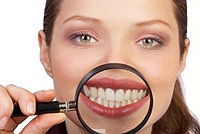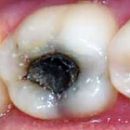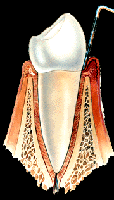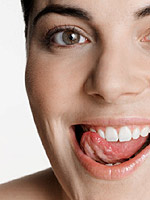Why our teeth get dark? What are the current teeth whitening methods? Answers to these questions you will find in the article.
Content
Why our teeth get dark?
Beautiful white teeth are a symbol of health and success. Yes, and who of us did not dream about a dazzling Hollywood smile?! If nature did not give you with snow-white teeth or they were left in the distant childhood, and you are not able to deny yourself in a cup of coffee or in a cigarette, do not despair - now it is just a matter of technology.
Teeth whitening was invented in antiquity. What was not used for this: nitric acid and even a file for stalking of the surface layer of enamel. It is known that in Ancient Egypt, the first toothpastes from wine vinegar and pumice were invented.
For centuries, dentists have tried many chemical methods and preparations, trying to invent the optimal teeth whitening method. Even enough dangerous materials were initially used.
Today, whitening has acquired a special popularity, because the bright color of the teeth is one of the most important indicators of their beauty. And the uncertainty and dull yellowness on the teeth pushes.
The main factor changing the color of the tooth is the accumulating flare, which draws into the dyes. Many foods have paint properties. For example, such as tea, coffee, chocolate, blueberries, red wine, soy sauce, berries, dark fruits and fruit sauces, tomatoes and tomato sauces / juices, dark vegetables and citrus fruits / juices, cola and t.D. They are able to paint teeth into colors from light brown to almost black. Also the cause of color change can serve as some medicines, smoking, genetic diseases. Inevitably, the color of the teeth is changing with age, since over time the enamel of the teeth is thinned, and the coloring effect of food and beverages increases.
Combining adverse factors and time will help various teeth whitening methods. The procedure itself will take quite a bit of time (from 25 minutes to 1 hour) and will allow any color to turn into a dazzling white.
Teeth whitening technologies are divided into home and professional.
Whitening methods
Home Method Provides for the use of a cast of teeth - capes and whitening gel. At home Cappa is filled with gel and puts on the teeth for the night or for several hours during the day. The course lasts from 3 days to a month and the longer it is, the better the bleaching effect. True, it's not necessary to count on too durable and strong results, since the concentration of the active substance is too small. But this method is simple and easy to use.
Professional whitening methods include: chemical bleaching, laser whitening, photo-blenage, ultrasound whitening, whitening with the Handiblassker system «Air-Flow».
Chemical bleaching - The most common method. The same substances (carbamide peroxide, urea peroxide, hydrogen peroxide, chlorides are used) as at home bleaching, but in much greater concentration. The solution is applied to the teeth, after which there will have some time (somewhere around half an hour) fixedly spend in the chair of the dentist. This method whitens the teeth strongly strongly and quickly, the result appears for 1-2 sessions, and the effect itself from whitening lasts from 2 to 5 years.
However, if you have visible seals, prostheses, pins and t.D., Most likely you will be offered another bleaching method, since foreign materials react differently with chemical elements and homogeneous whitening may not work.
Laser bleaching more deeply affects the tooth fabric, without harming. The special chemical composition is applied to the enamel of the tooth and is activated using a laser, depending on the operation mode of which the enamel brightens at once a few tones. This is the fastest, but also the most expensive bleaching way. An important condition for laser whitening is the presence of all seals, the absence of caries and periodontosis, as well as cracks and dumbles.
 Photo Overall carried out due to the impact on the whitening composition, which is again applied to the teeth, halogen light. The procedure itself will take 1.5-2 hours. The main advantage of the method is the lack of contraindications in sensitive teeth, teeth with cracks and chips, loose fillings and bare roots. The undoubted advantage is that with proper care, the bleaching effect may be preserved for life. The minuses include too strong whitening that is not all.
Photo Overall carried out due to the impact on the whitening composition, which is again applied to the teeth, halogen light. The procedure itself will take 1.5-2 hours. The main advantage of the method is the lack of contraindications in sensitive teeth, teeth with cracks and chips, loose fillings and bare roots. The undoubted advantage is that with proper care, the bleaching effect may be preserved for life. The minuses include too strong whitening that is not all.
Ultrasonic whitening It has a gentle effect on the enamel of the teeth, and also eliminates the flight and the dented stone. And the teeth themselves are processed by special pasta that repulse coloring pigments.
There is also a bleaching method combining Effects with water and ultrasound - ultrasound skaler. For those who have teeth themselves are white, and swelling over time under the influence of adverse factors, the restoration of natural color is best suited with the help of the Hendiblassker air-abrasive system «Air-Flow».
When using this method, the teeth are cleaned by a special mixture of water powder and compressed air. Bacteria, raid, interdental deposits are quickly and efficiently removed.
Before you go to the dentist to conduct a bleaching procedure, it is important to know that there is a series of contraindications for bleaching: diabetes, neuropsychiatric diseases, oncological diseases, caries, periodontal disease, allergic to peroxide compounds.
Whitening is not recommended for people wearing braces, pregnant and lactating women, children under 16.
Also contraindications for teeth whitening (except for photo and belting) are: root exposure, enamel cracks, seals requiring replacement, increased sensitivity of teeth.
In general, if white and healthy teeth still have your dream, in your power to make it reality. For this, just need to go through the bleaching procedure and the dazzling white-chapped smile will become your business card.









